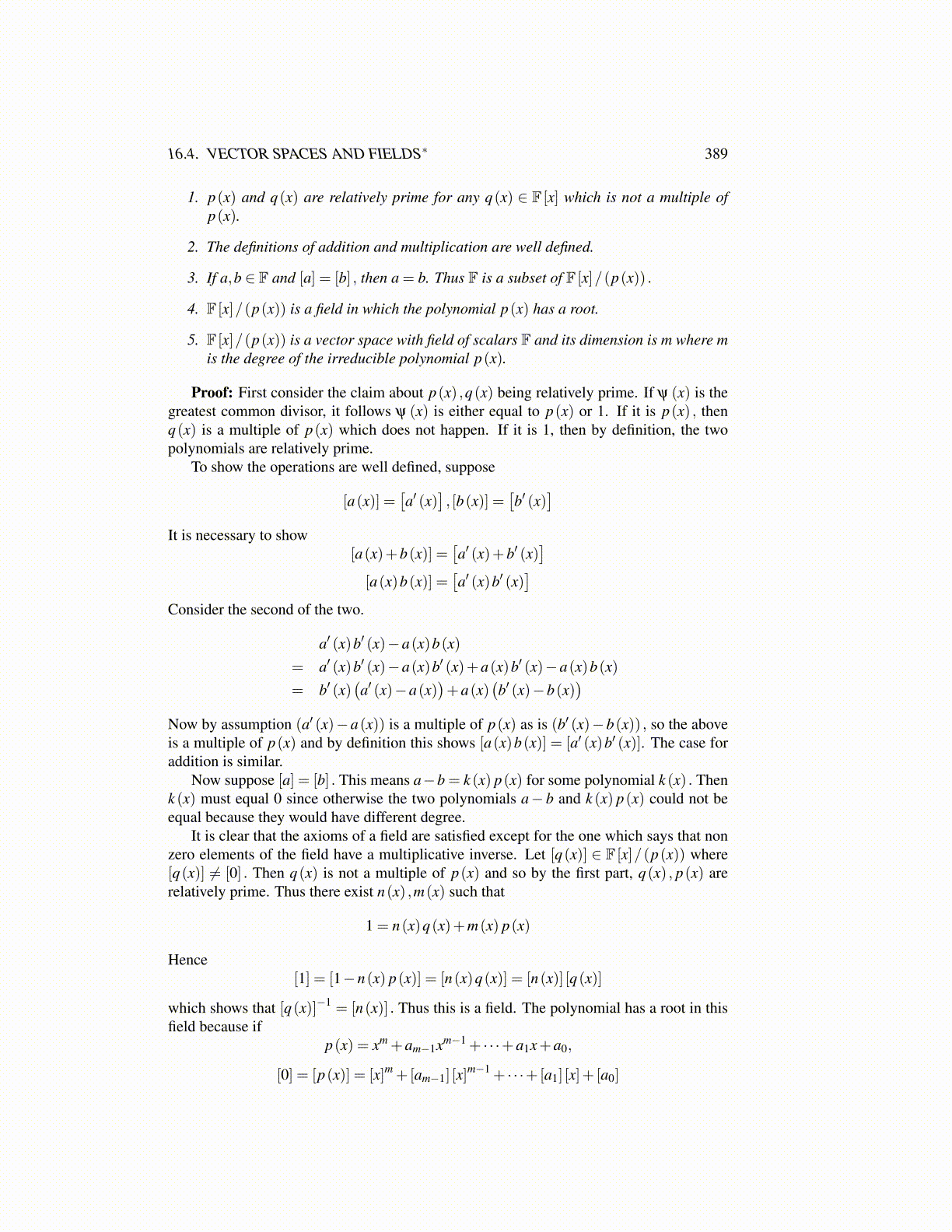
16.4. VECTOR SPACES AND FIELDS∗ 389
1. p(x) and q(x) are relatively prime for any q(x) ∈ F [x] which is not a multiple ofp(x).
2. The definitions of addition and multiplication are well defined.
3. If a,b ∈ F and [a] = [b] , then a = b. Thus F is a subset of F [x]/(p(x)) .
4. F [x]/(p(x)) is a field in which the polynomial p(x) has a root.
5. F [x]/(p(x)) is a vector space with field of scalars F and its dimension is m where mis the degree of the irreducible polynomial p(x).
Proof: First consider the claim about p(x) ,q(x) being relatively prime. If ψ (x) is thegreatest common divisor, it follows ψ (x) is either equal to p(x) or 1. If it is p(x) , thenq(x) is a multiple of p(x) which does not happen. If it is 1, then by definition, the twopolynomials are relatively prime.
To show the operations are well defined, suppose
[a(x)] =[a′ (x)
], [b(x)] =
[b′ (x)
]It is necessary to show
[a(x)+b(x)] =[a′ (x)+b′ (x)
][a(x)b(x)] =
[a′ (x)b′ (x)
]Consider the second of the two.
a′ (x)b′ (x)−a(x)b(x)
= a′ (x)b′ (x)−a(x)b′ (x)+a(x)b′ (x)−a(x)b(x)
= b′ (x)(a′ (x)−a(x)
)+a(x)
(b′ (x)−b(x)
)Now by assumption (a′ (x)−a(x)) is a multiple of p(x) as is (b′ (x)−b(x)) , so the aboveis a multiple of p(x) and by definition this shows [a(x)b(x)] = [a′ (x)b′ (x)]. The case foraddition is similar.
Now suppose [a] = [b] . This means a−b = k (x) p(x) for some polynomial k (x) . Thenk (x) must equal 0 since otherwise the two polynomials a− b and k (x) p(x) could not beequal because they would have different degree.
It is clear that the axioms of a field are satisfied except for the one which says that nonzero elements of the field have a multiplicative inverse. Let [q(x)] ∈ F [x]/(p(x)) where[q(x)] ̸= [0] . Then q(x) is not a multiple of p(x) and so by the first part, q(x) , p(x) arerelatively prime. Thus there exist n(x) ,m(x) such that
1 = n(x)q(x)+m(x) p(x)
Hence[1] = [1−n(x) p(x)] = [n(x)q(x)] = [n(x)] [q(x)]
which shows that [q(x)]−1 = [n(x)] . Thus this is a field. The polynomial has a root in thisfield because if
p(x) = xm +am−1xm−1 + · · ·+a1x+a0,
[0] = [p(x)] = [x]m +[am−1] [x]m−1 + · · ·+[a1] [x]+ [a0]